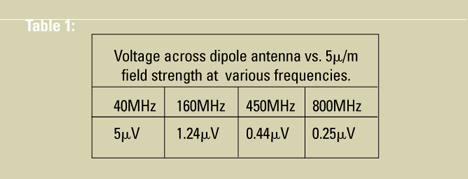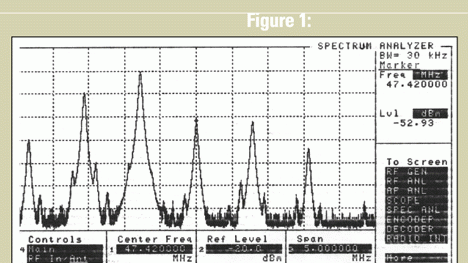Ensuring RF is a multi-faceted task
When first asked to write a column on the topic of “ensuring RF,” it was a bit unclear to me just what this meant. After thinking about it for a while, I came to the conclusion that ensuring RF doesn’t come down to one thing but instead many factors, including the following: ensuring the RF level is adequate for the purpose; keeping the RF signal in the right places — and out of the wrong places; ensuring the signal is clean; ensuring the signal is on the proper frequency; ensuring the signal is properly modulated; and maintaining a low standing wave ratio.
Let’s examine the task of ensuring a sufficient RF level. At a receiving location, suppose that the RF signal level is measured on a field strength meter and found to be 5 µV/m (microvolts per meter). Whether this is adequate RF signal strength depends upon the operating frequency, the particular antenna used for reception and the margin of reliability required for the application.
Suppose, too, that the operating frequency is 450 MHz, and the antenna is a half-wave dipole. The RF signal level appearing across the antenna terminal will be 0.44 µV. Note that this is the actual RF level at the antenna terminal and not at the receiver input terminal. The RF level at the receiver input terminal will depend upon any losses or gains between the antenna terminal and the receiver terminal (Figure 1). Let’s also assume that the combined cable and connector loss between the antenna and the receiver terminals is 3 decibels (dB). The RF level at the receiver input terminal then is 0.31 µV.

Further assume that the receiver requires an RF level of 1 µV for a good quality audio output signal. In our example, 0.31 µV is more than 10 dB below the required RF input level. Achieving the minimum RF level of 1 µV at the receiver input terminal would require that the field strength be increased by 10 dB. Thus, 10 dB above 5 µV/m is 15.8 µV/m. If this increase were accomplished by increasing the transmitter output power, it would have to be increased tenfold. Consequently, if a reliability margin of 20 dB is desired, the RF level at the receiver input terminal must be 20 dB greater than 1 µV, or 10 µV. The field strength at the antenna then would be 158 µV/m (10 (15.8 µV/m).
Note from Table 1 that, for constant field strength measured in microvolts per meter, the RF voltage level across the half-wave dipole antenna will vary with frequency, decreasing as the frequency increases. The voltage level (in microvolts) across the antenna terminal is equal to the field intensity in microvolts per meter plus the antenna factor. The formula for the antenna factor (in decibels per meter) is shown in Equation 1.

For example, at approximately 40 MHz, the antenna correction factor (K) is approximately 0 dB/m, making the ratio of microvolts per meter to voltage across antenna terminals practically 1:1. At higher frequencies, the ratio decreases. For example, at 160 MHz the ratio is 0.25:1. Thus, to achieve a constant 5 µV/m field strength at the antenna, the RF voltage across the antenna terminals at 160 MHz would be 1.25 µV (0.25 (5 µV).
Increasing the RF level at the receiver input can be done in several ways — by increasing transmitter power, increasing antenna gain at receiver and transmitter, decreasing losses at both transmitter and receiver, and increasing the height of the receiver and transmitter antennas.
Keeping RF in the right places and out of the wrong places might require the use of isolators. These devices allow RF signals to pass from the transmitter to the antenna with little attenuation but severely attenuate RF signals coming from the antenna toward the transmitter. This reduces intermodulation that might be caused by external signals mixing with the transmitter RF in the output stages.
This principle applies to duplexers, as well. Duplexers are required for repeaters where the receiver and transmitter utilize a common antenna. Since the transmitter and receiver must operate simultaneously, the transmitter RF must be kept out of the receiver input. There are two issues that must be addressed. First, the main transmitter signal must be kept out of the receiver front end in order to avoid desensitizing the receiver. Second, the transmitter signal contains noise sidebands that may mask the desired signal on the receiver frequency. The duplex filters must reject these sidebands or attenuate them to a level well below the desired receive signal.
Harmonics and other spurious signals must not be radiated from the transmitter at a high level. Filters are used to ensure that harmonic signals are severely attenuated before reaching the output of the transmitter and passed on to the antenna. Transmitters must be properly adjusted to avoid the generation of other spurious signals.
The following situation was discovered while doing some pro bono work for the local American Red Cross chapter. Using a broadband in-line wattmeter, the power output indicated about the normal output power. However, upon looking at the output with a spectrum analyzer, it was discovered that most of the RF power was in the wrong places. There were spurs all over the place (see Figure 1). Since a broadband RF power meter can’t separate individual RF signals that make up the transmitter output, it is important to check the RF signal with a spectrum analyzer to see whether the individual RF components contain spurious signals.
Ensuring that the RF signal is on the proper frequency is important for maintaining good communications within the radio system. And, just as important, it prevents interference with radio services on adjacent frequencies. Checking frequency is easily accomplished these days with the availability of low-cost hand-held frequency counters. Service monitors used in most shops these days are very stable and have sufficient sensitivity to monitor of the frequencies of distant stations using an external antenna.

Monitoring the deviation of the transmitter signal is quite important in order to prevent splattering RF over a broad spectrum. Again, modern service monitors with spectrum analyzers let the technician monitor the modulation, check the modulation spectrum emission and compare it to the FCC-mandated limits.
Finally, don’t forget the SWR. It is important to make sure that the transmitter “sees” a proper 50-ohm load impedance. High SWR can cause many RF problems in a transmitter. And, since most transmitters have a fold-back circuit, the RF power output of the transmitter will be reduced in the presence of a high SWR.
In summary, keep your RF clean. Keep it on the right frequency. Keep it out of the wrong places and in the right places. Avoid overmodulation. Monitor it with a spectrum analyzer; don’t rely simply on broadband power meters. Keep your antenna system maintained for best efficiency and low SWR. For best operation, the transmitter should be run at the rated power. This is particularly true for solid-state transmitter RF power amplifiers. Doing all this will keep you out of trouble with the FCC and in the good graces of your RF neighbors.
Until next time — stay tuned!














